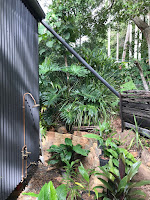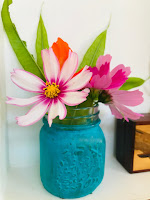Wow, what a crazy, neverending, full-of-surprises year it's been. Did your trip around the sun this year seem to take longer than the usual 365 days? Mine did. Maybe because so many of our regular milestones seemed to vanish in a fog of ever-changing Covid restrictions, cancellations and lockdowns.
Maybe 2021 seemed longer to me, too, because it was a big year, one that revolved around my new tiny house and included two momentous events.The months after that ticked by like items on my to-do list: insulation, plywood walls, architraves, skirting boards and the start of the neverending painting story (January). Kitchen cabinets, a beautiful little cedar feature wall and the 3.8m timber benchtop (February).
In March, after the front door went in (big milestone) and I got lights, power and water, I moved in. The tiny wasn't finished, but it was so exciting to actually, finally, sleep in it. I had to climb a builder's ladder to my bed loft every night (and move the ladder across the floor to reach the day loft). And there wasn't much storage yet without the built-ins so the place was part construction site, part domestic mess for a few months after that.
But I already knew I loved my new little home.The stairs went in early April, crafted by a local joiner. It was the one big thing we outsourced, and I'm glad we did; stairs are complicated, particularly when you want storage under them, and Matt did a beautiful job.
In May we finished all the big interior things: the desk (made from a panel of acacia), a built-in couch, and the ladder to the day loft. Then came the deck (in June) and a few built-in cabinets (July & August).Then... a five-week lockdown, a blink compared to months-long lockdowns others have had to endure, but it gave me a chance to really get to know my tiny home. And to rest.
I really needed to rest, and my body told me so. After almost a year of intense physical work, after feeling stronger than I've ever felt, my hands and wrists started aching and for a couple of months I couldn't even hold a screwdriver, let alone a power drill.
Everything checked out ok, medically speaking, but I had to stop doing all but the gentlest work.Every morning when I wake up, I check the weather from my closest window (without even lifting my head) before checking on my indoor plants, which always look as happy to live here as I am. Descending the stairs (designed for me, to suit my height, my leg length), I feel the curves of the timber handrail.
I might do some yoga on the deck, listening to rainbow lorikeets far above me. Or head to the beach for a swim, returning home to rinse off under the outdoor shower, looking up at the trees.
Living tiny is different in some ways. You have to be tidier than in a regular-sized house and clean more often (because you're using a small space constantly). I have chores now, such as managing the compost toilet and looking after all my plants and a veggie garden. And although it's in a beautiful spot now, there'll always be the issue of finding a suitable parking spot for it (though renting a patch of land costs much less than paying to live in even a small apartment).But tiny living is definitely for me. It's as if the way I live and how I feel inside have aligned and I'll always feel thankful that I had the time (thanks, Covid) and enough money and the right kind of support from others to do this project.
That inspired me to host my first-ever Christmas lunch, too, for three of us without families nearby. Until Covid cancelled that: I had to have a Covid test on Christmas morning, then self-isolate, and I'm still waiting for the results, FIVE days later...
So I'm writing this recap of 2021 while I wait, comfortably tiny house-bound, and thanking this crazy, incredible year, and 2020, for one of the biggest adventures of my life. It's been a wild ride. And 2022 will surely bring new experiences, different ones, but who really knows?All I do know is I'll try to start this next cycle the way I start every year: by finding a quiet spot to watch the sunrise on New Year's Day, close enough to the sea that I can feel the thick salt air on my skin and maybe have a swim, and give thanks to the year just past and send out hopeful wishes for the one just beginning. For more peace, understanding and kindness towards each other (non-human beings included) and for the planet we all call home. Happy 2022!
UPDATE, 30 December: Well, 2021 had one more surprise for me. My New Year's Day plans have now been squashed by Covid too. Got my PCR result back today and... I'm positive for Covid-19. Caught it at a party I went to last week where someone tested positive and I've had cold symptoms for a few days, but feel ok now. Just need to isolate for another five days. That first swim of the year is going to feel so sweet next week. Happy new year, everyone, and play safely!



























